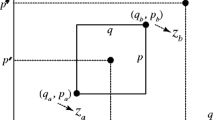Abstract
This paper considers the definitions of recursive and statelike representations form-D systems modeled as operators on a partially ordered Hilbert resolution space.
Using only the causality structure we develop a second-order transition representation which encompasses previously studied models. The same representation is shown to be valid for both quarter plane and arbitrary conic causality structures.
Transformation of the transition representation into a first-orderm-D local state model leads to the concept of structural minimality. We develop explicit conditions which apply to both stationary and nonstationary cases.
The transition representation also enables us to establish the existence of general 1-D wave advance model representations. Minimality of the wave advance model is also discussed.
Similar content being viewed by others
References
J. L. Aravena, State trajectories in Hilbert resolution spaces,Math. Systems Theory,19, (1986), 95–101.
J. Aravena and W. Porter, Ordered and partially ordered processing of multidimensional images,IEEE Trans. Acoust. Speech Signal Process.,33 (1985), 185–194.
R. DeSantis and W. A. Porter, Optimization problems in partially ordered Hilbert resolution spaces,Internat. J. Control.,5 (1983), 875–883.
R. Eising, Realization and stabilization of 2-D systems,IEEE Trans. Automat. Control,23 (1978), 793–799.
R. Eising, State space realization and inversion of 2-D systems,IEEE Trans. Automat. Control,27 (1980), 612–619.
A. Feintuch, and R. Saeks,System Theory: A Hilbert Space Approach, Academic Press, New York, 1983.
E. Fornasini and G. Marchesini, State-space realization theory of two-dimensional filters,IEEE Trans. Automat. Control,21 (1976), 371–379.
D. D. Givone and R. D. Roesser, Multidimensional linear iterative circuits—general properties,IEEE Trans. Comput.,21 (1972), 1067–1073.
S. Y. Kung, B. Levy, M. Morf, and K. Kailath, New results in 2-D system theory, Part II,Proc. IEEE,65 (1977), 945–959.
W. A. Porter and J. L. Aravena, 1-D models form-D processes,IEEE Trans. Circuits and Systems,31 (1984), 742–744.
W. A. Porter and J. L. Aravena, State estimation in discretem-D systems,IEEE Trans. Automat. Control,31 (1986), 280–283.
R. Saeks, State in Hilbert space,SIAM Rev.,15 (1973), 283–308.
W. Schnure, System identification: a state space approach, Ph.D. dissertation, Department of Electrical Engineering, University of Michigan, 1974.
M. Steinberger, A. Schumitzky and L. Silverman, Optimal control in Hilbert space,Proceedings of the International Symposium on Operator Theory of Networks and Systems, Lubbock, TX, 1977, Vol. 2.
Author information
Authors and Affiliations
Additional information
Supported in part by SDIO/IST and managed by ARO under Contract D24962-MA SDI.
Rights and permissions
About this article
Cite this article
Aravena, J.L., Porter, W.A. State representations form-D systems with generalized causality structures. Math. Systems Theory 20, 155–168 (1987). https://doi.org/10.1007/BF01692063
Received:
Revised:
Accepted:
Issue Date:
DOI: https://doi.org/10.1007/BF01692063



